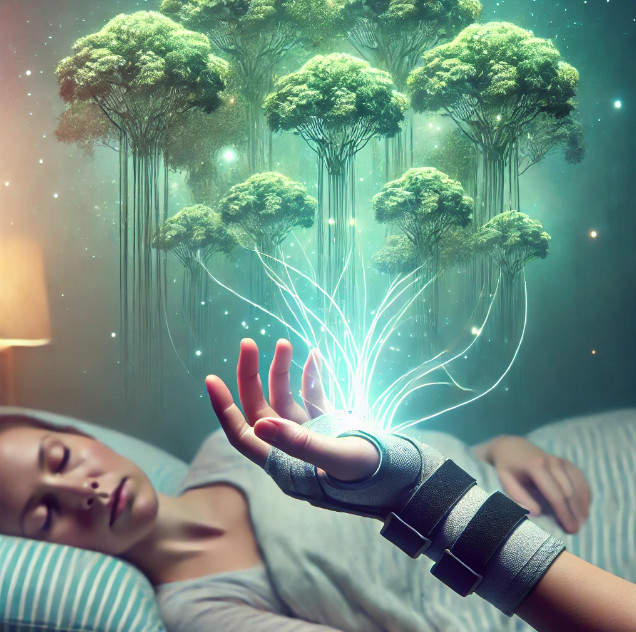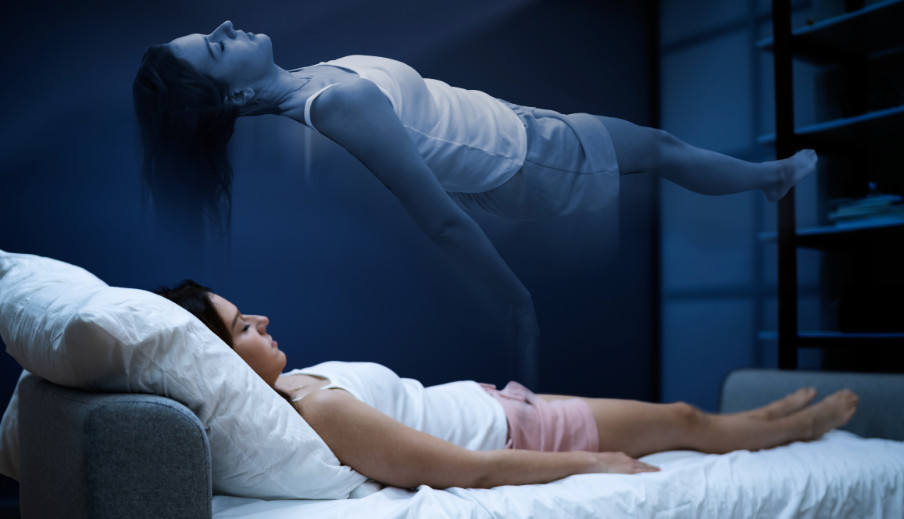Fascinating new research that confirms what creative minds like Salvador Dalí and Thomas Edison intuited long ago – the drowsy period as we drift off to sleep can supercharge our creative abilities. Researchers from MIT and Harvard (Horowitz et al., 2020, 2023) demonstrated that deliberately influencing dreams during sleep onset (known as N1 sleep or hypnagogia) can significantly boost creative thinking.
Using a sensor-laden glove called Dormio, that detects when people enter this generative sleep stage, the team conducted an targeted dream incubation (TDI) experiment in which they prompted participants think about trees as they dozed off. The results were remarkable. People who had tree-related dreams during sleep onset performed far better on subsequent creativity tests compared to those who stayed awake or slept without the tree suggestion. Even more intriguingly, the more that participants incorporated trees into their drowsy dreams, the more creative their later responses became.
In the hypnagogic state, our usual mental boundaries become more permeable and fluid, allowing novel ideas and strange combinations of thoughts to emerge. The research has shown that our minds naturally make broader, more distant connections between concepts during sleep onset. What is significant about this study is that it’s the first to demonstrate a direct causal link between specific dream content and enhanced creativity. Previous research has demonstrated that sleep boosts creative problem-solving, but this study shows that we can actually guide our dreams to offer creative new ideas and solutions in specific areas of inquiry.
The implications are exciting. The study shows what many of us dream afficionados already understand – that it’s possible to harness your sleep onset period to enhance creative thinking around specific questions. While more research is needed to fully understand how long these effects last and how they might apply to different types of problems, this study lends credence to the idea that ‘sleeping on it’ really does help us find solutions not available to our waking minds.
For those interested in experimenting with this yourself, the key period is that drowsy state just as you’re falling asleep. While you may not have access to the Dormio device, simply holding a specific problem or theme in mind as you drift off could spark creative insights. Dormio detects alterations in sleep states and offers timely prompts to capture a whole series of pre-sleep dream images. It then records verbal N1 dream reports immediately. If we wait until morning to write our liminal reams down, most of these early images will be forgotten. So taking a cue from this research, try using a smartphone to record verbal dream reports as soon as you are awake enough to become aware of them. You may find you record many dreams throughout the night, not only in sleep onset, and develop a fuller picture of your creative dreaming mind.
Dali and Edison were known to deliberately harness the dreams from sleep onset by napping in a chair with an object in their hands that would clatter to the floor as soon as the muscle relaxation in early sleep released the object. The noise would wake them up and they would then record dreams that became fodder for inventions for Edison and surreal images for Dali.
The next frontier in creativity research may well be in understanding how to better utilize these unique states of consciousness that we all experience every night. As this study shows, our dreams might hold more practical value than we ever imagined.
What are your experiences with creative insights during sleep onset? I’d love to hear about them in the comments below.
The paper describes Dormio, a novel device designed to study and influence dream content during the hypnagogic period (sleep onset). The device uses sensors to detect when users are falling asleep and delivers targeted audio prompts to influence dream content, a process called targeted dream incubation (TDI).
The researchers conducted a study with 49 participants divided into sleep and wake conditions, with and without prompting to think about “trees.” The Dormio device monitored heart rate, finger muscle tension, and electrodermal activity to detect sleep onset. When sleep was detected, the device would wake participants and ask them to report their mental experiences before providing new prompts.
Key findings:
- 67% of prompted sleep condition reports contained references to trees
- Only 3% of unprompted sleep condition reports mentioned trees
- 52% of prompted wake condition reports mentioned trees
- 0% of unprompted wake condition reports mentioned trees
The device successfully demonstrated its ability to influence dream content during sleep onset. Dream reports showed increasing bizarreness and immersion with subsequent awakenings, while maintaining the targeted theme.
The research builds on previous studies showing that dream content can predict post-sleep memory enhancement and that sensory input during sleep can influence memory consolidation. While other techniques like Targeted Memory Reactivation (TMR) have shown that presenting sensory cues during sleep can enhance memory consolidation, Dormio provides a way to study the subjective experience of memory processing during sleep.
The researchers suggest several potential applications for Dormio and TDI:
- Studying the causal relationship between dream content and memory consolidation
- Enhancing creativity through directed dream experiences
- Understanding the role of dreams in processing daily experiences
- Investigating memory formation and integration during sleep
Limitations of the study include:
- Limited age range of participants
- Lack of polysomnographic validation of sleep stages
- Reliance on subjective dream reports
- Use of only one incubation theme (“tree”)
The researchers emphasize that while they can demonstrate correlation between dream incorporation and memory processing, they cannot yet prove whether dreaming itself causes memory consolidation or is simply a reflection of underlying processes.
The Dormio device represents a new tool for studying dreams and consciousness that is more accessible than traditional sleep lab equipment. It enables controlled manipulation of dream content, which could help answer fundamental questions about the role of dreams in memory, creativity, and cognitive processing.
The authors propose future studies using Dormio to investigate whether deliberately inducing specific dream content can enhance learning and memory consolidation, potentially opening new avenues for cognitive enhancement through dream engineering.
Join me on substack for an ongoing journey into the world of dreaming!
www.https://dreamsdemystified.substack.com/
Subscribe to get full access to my complete book chapters, publication archives, and to come: recordings, lectures, papers and more.
Horowitz, A. H., Cunningham, T. J., Maes, P., & Stickgold, R. (2020). Dormio: A targeted dream incubation device. Consciousness and cognition, 83, 102938.
Horowitz, A. H., Esfahany, K., Gálvez, T. V., Maes, P., & Stickgold, R. (2023). Targeted dream incubation at sleep onset increases post-sleep creative performance. Scientific reports, 13(1), 7319.










